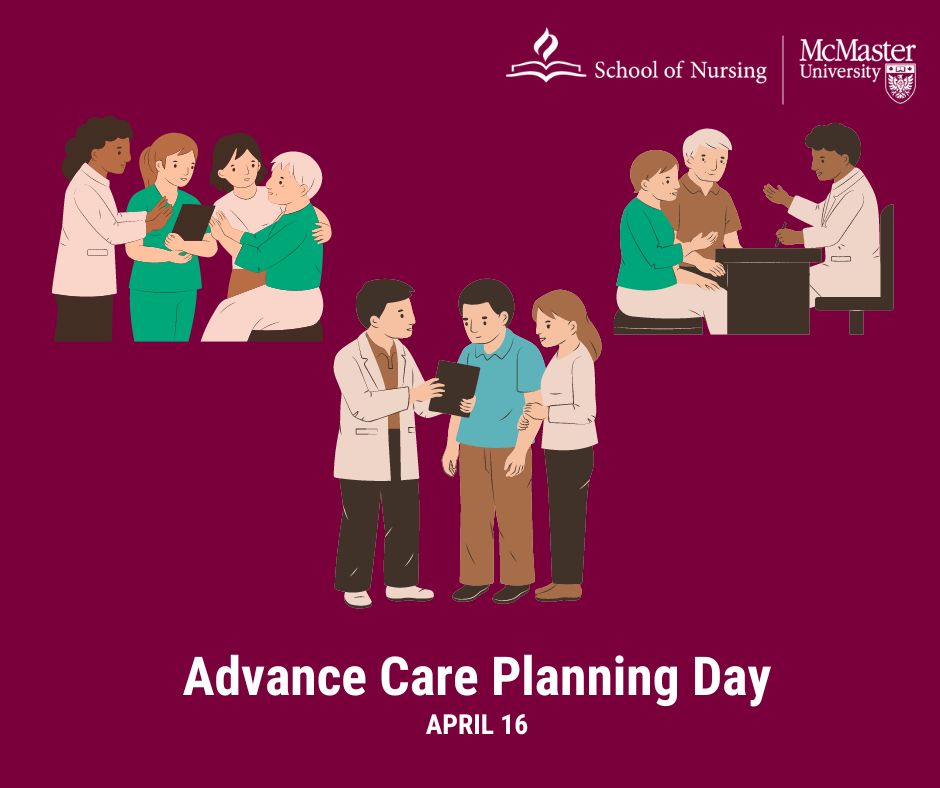April 16, 2023
Madelin Moses, McMaster University School of Nursing
FOR NATIONAL ADVANCE CARE PLANNING DAY, WE ASKED SHARON KAASALAINEN ABOUT THE IMPORTANCE OF ADVANCE CARE PLANNING AND NORMALIZING CONVERSATIONS THAT COME WITH IT.
“Often people think ‘I’m healthy, I’m young, I don’t need to worry about this or even start thinking about it.’ But if we broaden it and view it as overall planning for the future, I think we’ll get more uptake” says McMaster’s School of Nursing professor, Sharon Kaasalainen, regarding the importance of starting a discussion about advance care planning sooner rather than later.
Advance care planning is all about preparing you and your substitute decision maker (SDM) for all your future healthcare situations and possible decisions. Your SDM is the person or people who are legally allowed to make healthcare decisions for you in the situation where you’re unable to make them for yourself. It is usually assumed that advance care planning would just be for the elderly, but it’s important for every age group to consider. Kaasalainen says, “the way I’m used to using the term mostly has to do with health care planning, but it’s also important to legal and financial planning as well. I think that’s a good thing, because we’ll get people thinking that is it for everyone.” She has been working with the Canadian Hospice Palliative Care Association, where they developed a new national framework that includes a legal tool kit as well as a health care tool kit to help with those thinking about planning for the future.
There are five crucial steps that make up the process of advance care planning. The first is to identify and decide on who your substitute decision-maker(s) will be. In Ontario, an individual’s closest living relative is automatically decided as their SDM, unless otherwise specified. The second step is to learn about your current overall health status and talk to your doctors or other healthcare providers about what you may need as time goes on. The third step is to think and reflect on what your values, wishes and beliefs are. This will help you decide on what healthcare decisions could be right or wrong for you. The fourth step is to then talk about your values, wishes and beliefs with your SDM(s), health care providers, and even with your family and friends as well. This will ensure that in the situation where you are unable to communicate for yourself, everyone will know what you would want for yourself and your health journey. The final step in the process is to continue to include your SDM(s) in all relevant conversations whenever possible so that they will always feel prepared.
There are a couple ways in which as a society we can influence people to take action to plan for themselves at an earlier age. A solution that Kaasalainen came to is to leverage different moments in life to prompt someone to think about planning. Specifically, when they’re already thinking about a possible threat to their well-being. Advance care planning isn’t always about death; it could come into action when you are unconscious from an accident but eventually recover. One moment to leverage that she uses as an example is when an individual is applying for and receiving their driver’s license. The individual will fill out the appropriate forms and paperwork, which includes an organ and tissue donor registration form. By including additional questions to the form, possibly such as who they would want their SDM to be, we can help begin that individual’s advance care planning as early as 16 years old. “We never know when we’re going to die, you could be 16 years old, you could be 25, you could be 80. But trying to use those moments that people are thinking about the possibility of a serious injury or death can create opportunity for planning and healthy discussion” says Kaasalainen.
Another way to influence people to discuss planning at an earlier age is to normalize conversations around death and your wants and needs for during the end of your life. Kaasalainen mentions, “it’s not all about where you die, how you die, but sometimes thinking about what’s important to you…. and making sure your substitute decision maker knows these things as well.” It can be as simple as discussing your favourite foods or music. Or who you would want to support you during your last few years or months of your life. Kaasalainen shared a perfect example of this, involving a substitute decision maker and his father. The son noticed that the care home his father was staying in was only playing classical music. He mentioned to the caregivers that his dad hates classical music and has always loved hard rock music. After giving the father headphones and playing hard rock music for him, he instantly began moving his head with the music and smiling. “If it wasn’t for that substitute decision maker knowing that about his dad, his dad would’ve been in a more stressful situation having to listen to this classical music that he didn’t enjoy” says Kaasalainen.
Thinking, discussing, and planning for your future healthcare needs is not only important for yourself, but for those around you. Finalizing your plan won’t happen all at once, and it is often a slow and continuous process of conversations. This will allow you to gather information over time to assist you in making the best decision for you. And starting this process early prevents you from trying to plan in the moment of stress or a crisis. To learn more and possibly start your advance care planning, please visit https://advancecareplanningontario.ca/.

